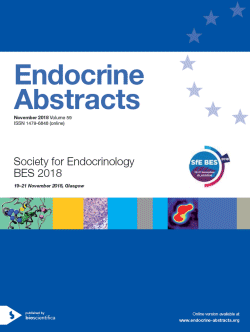Searchable abstracts of presentations at key conferences in endocrinology

Society for Endocrinology BES 2018
Glasgow,
UK
19 Nov 2018 - 21 Nov 2018

The Society for Endocrinology BES will take place 19-21 Nov 2018 in Glasgow. Come and exchange knowledge, share experiences and strengthen collaborations across our global community of endocrinologists.
APPLIED PHYSIOLOGY WORKSHOP
GPCRS: hotspots and complexes
ea0059apw1.1 | GPCRS: hotspots and complexes | SFEBES2018
Calcium-sensing at 25 years
This year marks 25 years since the calcium-sensing receptor (CaSR) was first identified in bovine parathyroid and the receptor has since emerged as a fundamental contributor to extracellular calcium (Ca2+e) homeostasis, by regulating parathyroid hormone release and urinary calcium excretion. The CaSR is a class C GPCR that is functionally active as a homodimer. It couples to multiple G-protein subtypes to activate intracellular calcium mobilisation and mi...
ea0059apw1.2 | GPCRS: hotspots and complexes | SFEBES2018
FSH, Body Fat, Bone Mass and Biological Aging
Pituitary hormones have long been thought solely to regulate single targets. Challenging this paradigm, we found that both anterior and posterior pituitary hormones, including FSH, had other functions in physiology. We have shown that FSH regulates skeletal integrity, and, more recently, find that FSH inhibition reduces body fat and induces thermogenic adipose tissue in wild type mice, phenocopying genetic haploinsufficiency for the FSH receptor. A polyclonal antibody raised a...
ea0059apw1.3 | GPCRS: hotspots and complexes | SFEBES2018
The nanodomain organization of GPCR signalling: lessons from TSH receptors and beyond
My group investigates the basic mechanisms of G protein-coupled receptor (GPCR) signalling and their alterations in endocrine disease, which we study using innovative microscopy methods such as fluorescence resonance energy transfer (FRET) and single-molecule microscopy. Using these methods, we have demonstrated that GPCRs do not only signal via cyclic AMP at the cell surface but also at intracellular sites (Calebiro et al., PLoS Biology 2009). We have shown that this is requi...



